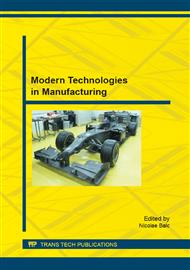[1]
M.S. Rashid, Dual-Phase Steels, Ann. Rev. Mater. Sci. 11 (1981) 245-266.
Google Scholar
[2]
S.A. Golovanenko, N.M. Fonshteyn, Dual-Phase Alloyed Steels, Metallurghia, Moscow, (1986).
Google Scholar
[3]
Information from European Standard EN 10020: 2000, Definition and classification of grades of steel.
Google Scholar
[4]
Information to http: /ed. iitm. ac. in/~shankar_sj/Courses/ED5312/Materials_for_Automobiles11. pdf, Materials for Automobiles, Ann. Lec 11, HR & CR Flat products, 26 September (2011).
Google Scholar
[5]
A.J.H.J. Schellekens, Microstructural modeling of dual-phase steel, Master Thesis, 2010, available at: http: /www. mate. tue. nl/mate/pdfs/12128. pdf.
Google Scholar
[6]
A.H. Nakagawa, G. Thomas, Microstructure-Mechanical Property Relationships of Dual-Phase Steel Wire, Metallurgical Transactions 16A (1985) 831-840.
DOI: 10.1007/bf02814834
Google Scholar
[7]
C. Oliver, Dual-Phase Steel Characterization for Tube Bending and Hydroforming Applications, Master Thesis, 2010, available at: http: /scholar. uwindsor. ca/cgi/viewcontent. cgi? article=1201&context=etd.
Google Scholar
[8]
B. Pawlowski, Critical points of hypoeutectoid steel – prediction of pearlite dissolution finich temperature Ac1f, Journal of Achievements in Materials and Manufacturing Engineering 49, Issue 2 (2011) 331-337.
Google Scholar
[9]
C. Dulucheanu, N. Bancescu, T Severin, The Influence of Quenching Temperature on the Structure of a Dual-Phase Steel with 0. 094% C and 0. 53% Mn, article accepted for publication in Applied Mechanics and Materials, (2015).
DOI: 10.4028/www.scientific.net/amm.809-810.507
Google Scholar
[10]
Information on http: /metal2013. tanger. cz/ files/proceedings/ metal_09/Lists/Papers/ 032_e. pdf, K. Burikova, G. Rosenberg, Quantification of microstructural parameter ferritic-matertensite dual-phase steel by image analysis.
Google Scholar
[11]
G.R. Speich, R.L. Miller, Mechanical Properties of Ferrite-Martensite Steels, in: Structure and Properties of Dual-Phase Steels, ed. TMS-AIME, New York, 1979, pp.145-182.
Google Scholar
[12]
R.G. Davies, C.L., Magee, Physical Metallurgy of Automotive High Strength Steels, in: Structure and Properties of Dual-Phase Steels, ed. TMS-AIME, New York, 1979, pp.1-19.
Google Scholar
[13]
A. Bag, K.K. Ray, E.S. Dwrakadasa, Influence of Martensite Content and Morphology on Tensile and Impact Properties of High-Martensite Dual-Phase Steels, Metallurgical and Materials Transactions 30A (1999) 1193-1202.
DOI: 10.1007/s11661-999-0269-4
Google Scholar
[14]
Information on http: /www. metal2015. com/files/proceedings/ metal_09/Lists/Papers/107. pdf, E.N. Birgani, M. Pouranvani, Effect of Martensite Volume Fraction on the Work Hardening Behavior of Dual Phase Steels.
Google Scholar
[15]
Information on http: /eprints. nmlindia. org/4210/1/68-79-Debdulal_Das. PDF, D. Das, P.P. Chattopadhyay, A Study on the Effect of Martensite Morphology on Mechanical Properties of High-Martensite Dual-Phase Steels.
Google Scholar
[16]
Y. Tanaka, Y. Hosoya, K. Nakaoka, Possibilities of Achieving Low Yield Ratio with Lower Manganese Dual Phase Steels, in: Metallurgy of Continuous-Annealed Sheet Steel, ed. TMS-AIME, New York, 1982, pp.251-269.
Google Scholar


